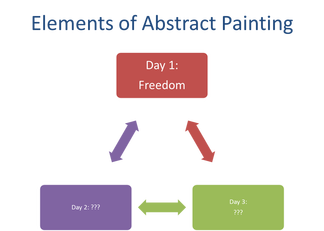 Day 1 - Freedom Day 1 - Freedom Last week I was fortunate to take an amazing art workshop. I'm not sure I'll be able to fully capture the experience, the impact, but I'd like to try. The Ann Arbor Art Center offered a "4-day abstract painting intensive" taught by abstract artist Ruth Gilmore Langs. The class met for 2 1/2 hours on four consecutive days to get an introduction into abstract painting using acrylics. The idea - bring one fairly large canvas (minimum size 20" x 20") and work on creating an abstract painting. I paint in watercolor and I usually work on a smaller scale. My work tends to be more realistic or impressionistic. It often leans toward trying to express the beauty and peace found in nature. But I've wanted to loosen up my style more and find abstracts interesting. I have no formal understanding of how to go about painting an abstract work. I love to learn. So this looked like a great class to take. Sign me up for this intellectual and creative pursuit! Eighteen women artists of varying experience showed up for the class. Pretty large group and just a bit intimidating (did I say "a bit"). Ruth seemed unphased and assured us there would be plenty enough space and one-on-one time for each of us. And we began. Day 1 - - How to begin? Freedom. Ruth wrote "freedom" on the board. She then asked: What is art? - Your reaction to the world. - Your unique view of what makes you - you. We discussed fear; facing a blank canvas. Then we talked about freedom of expression. - Be a kindergartener, a preschooler. Paint like a child. - Forget the rules. No rules. Be free. - Well there was one rule: Don't use little brushes or paint detail. If you must paint detail, paint it the size of a postage stamp to get it out of your system. Then go back to the big brushes, big strokes. - Just paint - express yourself without judgment. - Only you know what you are thinking or feeling as you put paint to the canvas. - Explore color and movement. Then Ruth offered how to start (don't quote me though) - Pause and meditate for a few moments. - What is your color for today? What is your soul color? - Cover your canvas in that color. - Then pick other colors and add them to the painting. - Interact with your canvas as you put down a color, a stroke: How does it look? How do you respond? - It's you and your canvas - a team - back and forth. - Play. Be free. Set aside judgments. Set aside fear. - Go! And so I began. - Meditate? Yes, I can do that. I try to practice mindfulness meditation. Meditating is a great suggestion especially since I'm feeling a bit overwhelmed standing before this large empty white canvas, feeling quite exposed. - Soul color? Say what? Don't panic, don't judge. Soul color - cool idea. Closing my eyes, I tried to take those three deep breaths. Chatter - people are already starting to paint. Just breathe, just breathe, just breathe. Bam! And there it was in my mind - green! "leaping greenly spirit of trees..." a line from e. e. cummings' poem, "i thank you god for most this amazing day... "* His love poem to nature, to being present, to gratitude. It's been a favorite of mine since college. Start with green. How do these acrylics work? How do you blend the various greens that came in this cheap little set of paints? How do my brushes work (old house painting brushes of various sizes that Ruth suggested bringing)? How freeing it was not to worry about "saving the precious whites" - as you do with watercolor. Using white paint is allowed - how radical! And I painted as a child - slapping on green paint, no rules, no careful wash. I filled the canvas and even painted the sides. Green, green (verde, verde, que te quiero verde!**). And stepped back to let the vibrant grass-green dry. Now what? Stall - clean my water, visit. One person noticed my canvas (most folks had their painting turned to face the wall but my location didn't quite allow me to hide as much as I'd have liked). "Green" she said. "What does green represent? Ah, the color of greed." Surprised (I guess it IS an abstract already subject to personal interpretation), I said softly, "i was thinking more of healing, of nature." Clearly, the kindergartener had more work to do. Add those "leaping greenly spirit of trees". And the "blue true dream of sky" and "the sun's birthday" and "wings". The kid in me began rapidly painting the spirit of primitive pine trees with blues and greens. Then Ruth walked by and reminded us to take our time as we added paint to the canvas; to respond to the stroke and the color as it lands on the canvas. Interact with the canvas. Ah, yes, take a breath, slow down, enjoy - look - paint - have fun. And so hints of wispy clouds began to appear in the green sky, a couple white curvy "v's" for wings. And then the sun. Big red, round swipes of the brush and a bit more red in other places to tie the painting together. Good to add red - the complement of green. Oh-oh! Those rules started creeping in. Blue - add more blue - dark blue to the sun and below the trees. And now step back. Wild, fun, a bit frenetic. Time to clean up, go home, wonder what tomorrow would bring. 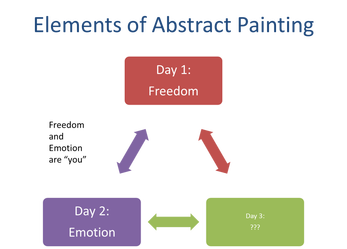 Day 2 - Emotion! Day 2 - Emotion! Day 2 - - Emotion. The word "Emotion" joined freedom on the board. Ruth now asked: What is abstract painting? - An abstract painting eliminates recognizable forms, we learned. - It is all based emotion. The painting is more physical, expressive. - Abstracts are painted with feelings, emotions unlike traditional landscapes and still lifes. She showed us examples of works by Joan Mitchell and Hans Hoffman. - We discussed how the paintings convey a feeling and meaning that is subject to the interpretation of the viewer. - An abstract does not rely on objects as do landscapes for example. - Abstracts rely on using and evoking emotion. Ruth asked us to continue working on our painting - adding a new layer: - Go back to your canvas and meditate once again. - What is today's soul color? - What emotion(s) are you feeling? If you are feeling more than one emotion, pick one of them. - Paint that. I stood before my rather chaotic canvas. Please know that I'm a private person, not big on expressing my feelings publicly (or privately or at all). That being said, I wanted to differ with her point about landscapes being painted without feeling. I do try to convey feelings, mood, message in my paintings. Perhaps I was being defensive. So I said nothing and tried to go with the spirit of the lesson. Meditate. And what did I notice? A massive headache (I was coming off a prednisone trial - one crazy-making drug), sadness, anxiousness about the state of my painting, excitement about working more on the happiness and hope in the poem. Which emotion should I paint? It would be easiest to go with the upbeat feelings. But EMOTION - big EMOTION. Gulp - okay, dare I let the sadness and pain in? The painting is kind of a mess anyhow, what do I have to lose (so much for non-judgment)? And the poem does have two sides to it. Cummings utters "i who have died am alive again today". So, be brave. Don't avoid. Notice. After all isn't that what mindfulness is all about? Remember what Ruth said: no one knows what you are thinking. It's you and the canvas. A personal conversation. I stared at my painting for a very long time as the activity around me began to swirl. I sipped my chai tea trying to calm myself. How to express this? I reached for my water bottle and sprayed the blue-green sky and the red sun and the tops of the greenly spirit of trees. And they began to weep, gray tears running down the canvas and falling to the floor. Paint sobs dripping everywhere as I watched. And then I cried. "i who have died, we who have died". Shared tears were running down my cheeks. Picking up the painting I tipped it right, then to the left; the tears flowing across the landscape and back again. I wiped the tears and blotted them and added deep blue to the running streaks and to the trees and to the fading sun and to the blurred wispy white clouds. I covered the soaring wings until just hints of them appeared. I added darkness, sadness until my heart could say no more except: stop; notice, breathe. Ruth walked up to see how it was going. "It's been a day." I'd told her the day before about the poem and had brought her a copy. And I explained that I'd painted the other side of the poem: deep sadness. But now I needed to go to my "happy place". So I returned to the "gay great happening illimitably earth" and began filling the lower, still green area with hints of flowers - bright yellows, oranges, reds, blues (happy blues), bits of white. Three-thirty - time to taking my splitting head, my exhausted self out of there. I couldn't even imagine what day 3's word would be and if I could endure. 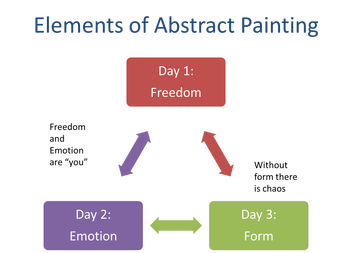 Day 3 - Form Day 3 - Form Day 3 - - Form. Day 3 continued the discussion about what is abstract art. - Abstracts are flat surfaces that show the "interior of the subject" (Mondrian). While non-abstract landscapes and still life paintings tend to have a 3-dimensional feel and/or show perspective. - Without form there is chaos. - Form can be thought of as the shapes and focal point in your painting. It is one aspect of the broader composition. What Next? - Go back to your painting and find your big shapes. - Add some if there are none. - Expand or highlight them if they are not apparent. Looking at my painting, I had achieved chaos for sure. How could I add form? Ruth helped me find some shapes and suggested adding more flowers (yeah), expanding the clouds, the blue tree "forest", and the dark reddish puddle; to leave the bright greens on the right side that survived yesterday's shower. So I spent the day playing with form as best I could. But there was so much self-judgment and self-comparison: what a mess, what a crime scene; so many really beautiful paintings by the rest of the class and some doing 2 or 3 paintings. I'm still working on the same canvas; the same canvas, the only canvas I have. But there's nothing to lose, lots to learn about layering, accepting, pushing, interacting with that canvas and the emotions that are bubbling. And in the mindfulness world isn't all that internal noise just a bunch of thoughts, not facts? Just notice, breathe, keep painting. Look for the forms: Highlight the clouds. Find the lost trees. Accent the red "lake". Add some more flowers. Keep going. Pop the sun out - add those rays. Then call it a day. 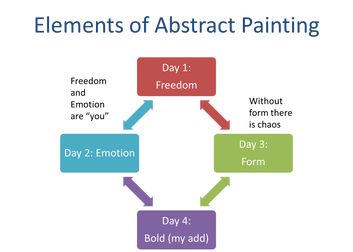 Day 4 - Bold Day 4 - Bold Day 4 -- Bold Ruth's "elements of abstract painting" drawing formed a triangle - three concepts: freedom, emotion, form. What could day 4 be about? Ruth's word of the day: Continue. - Work on form. - Then we'll reconvene and have a "gallery walk" at the end. There was so much to think about after the first three days. - Overwhelming emotion. - Child-like freedom. - Elusive form. - Comparing the experience of abstract painting to how I typically work. Still discouraged and surprised by my painting, what did I need to bring to this last day? My personal word of the day would be: Bold. - Be bold! - Bring the sun back to life while taming those rays! - See the trees for the forest (really)! And really what it came down to was to be bold in staying the course, staying with myself and, yes, changing the sun so it was bursting yet more abstract. And those flowers - those flowers that reminded me that emotions may be deeply felt and that they also change. Highs to lows and in between. How great it is to stop often, see, hear, touch, breathe and be "lifted from the know of all nothing." I'd not only painted the poem, I'd just lived it. And oh, what did I now think about the troubling idea that my past work or the work of wonderful landscape and still life artists hadn't been painted with feeling? I talked with Ruth about it at the end. My revised view: landscapes do try to convey feeling often with the aid of "objects" or a recognizable scene. But while painting this abstract, there were no photographs to reference or replicate. I was painting from inside out. I wasn't trying to convey an emotion. I was embracing it, immersed in it and perhaps transformed just a bit by it. i thank you god for most this amazing day... References: The Transformation Summary (Days 2-4)
7 Comments
|
AuthorMary Murphy Archives
March 2019
Categories
All
|
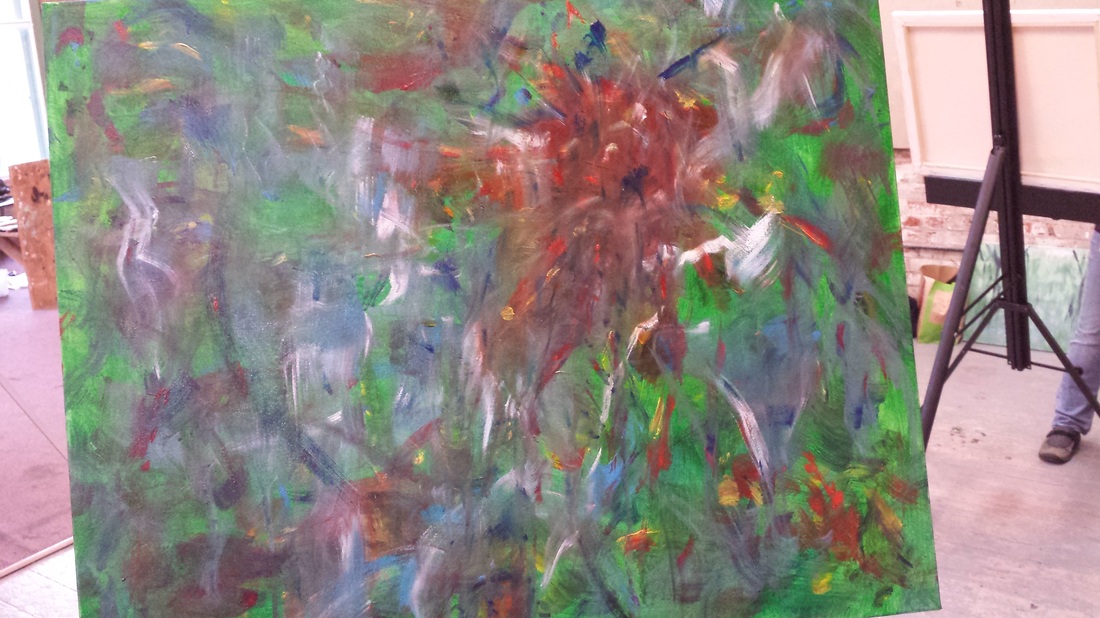
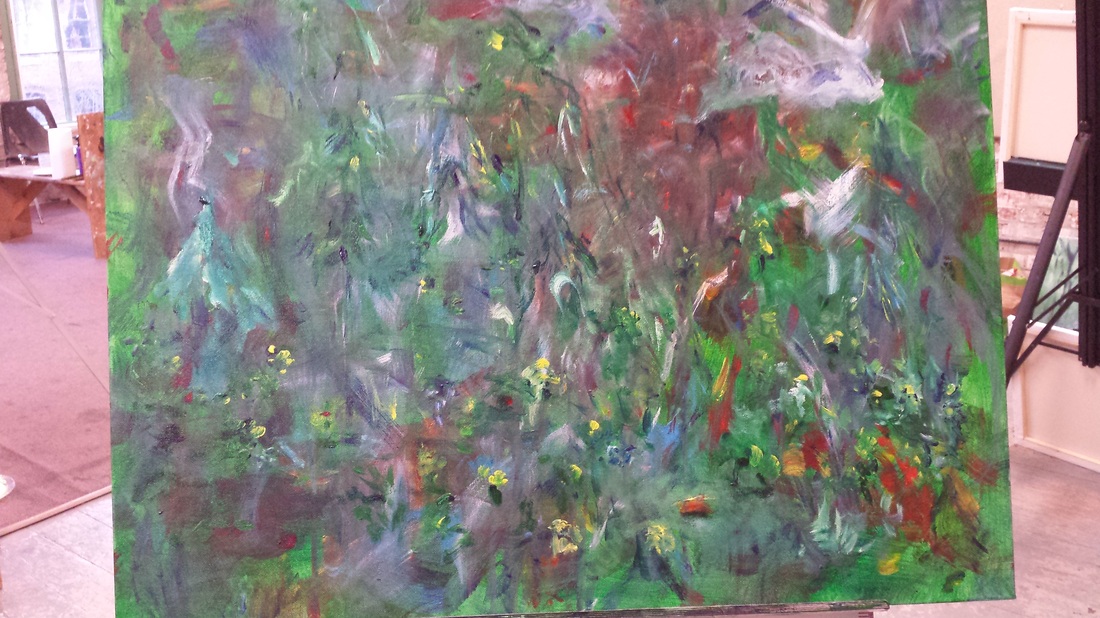
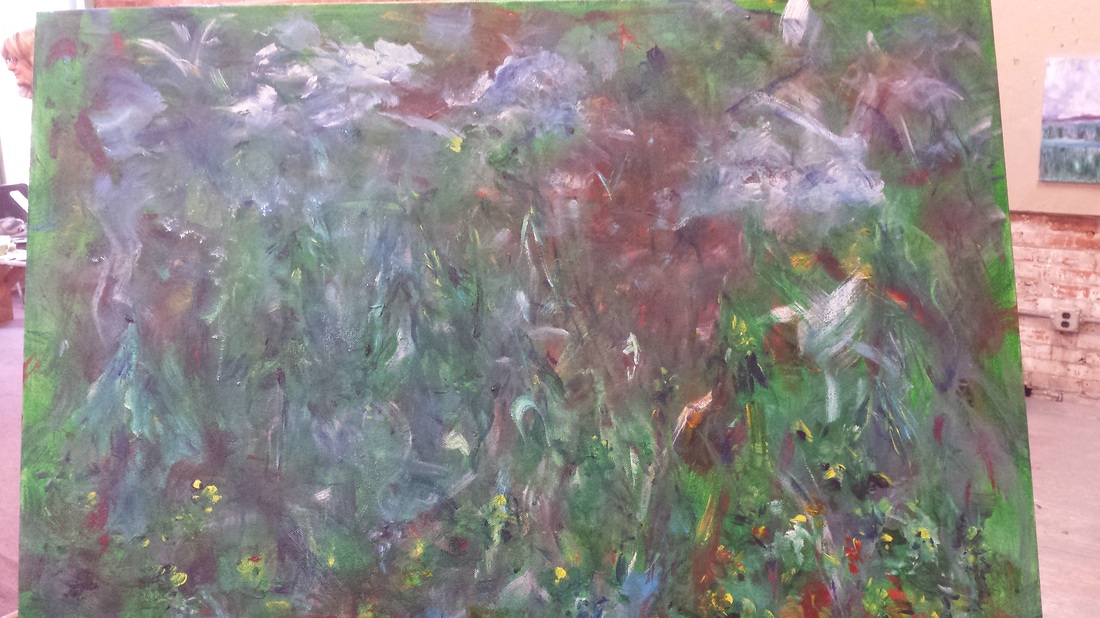
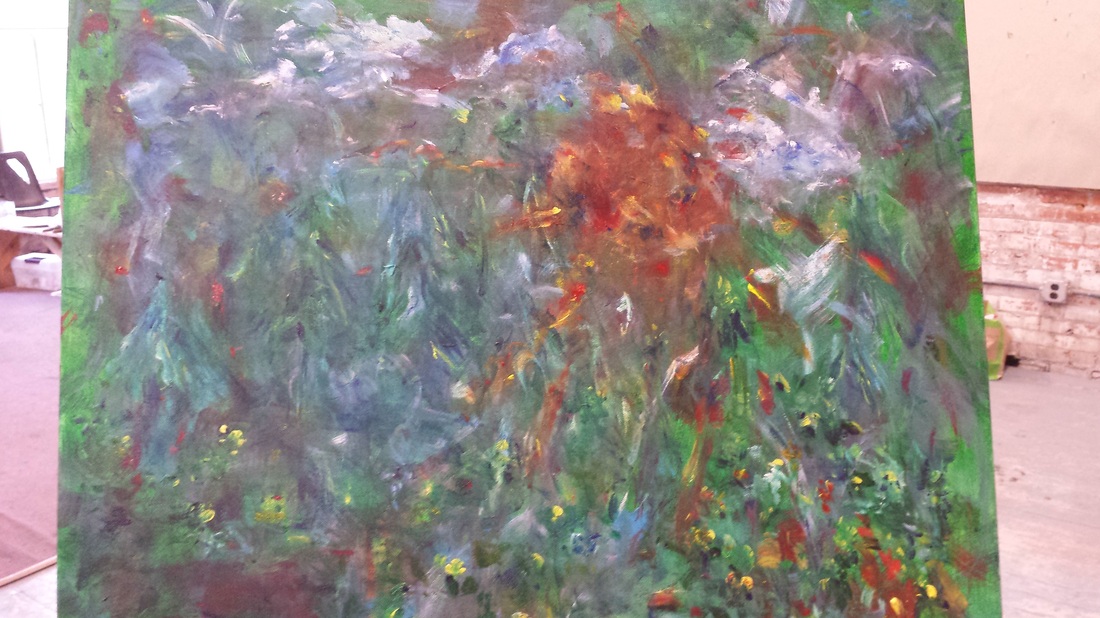
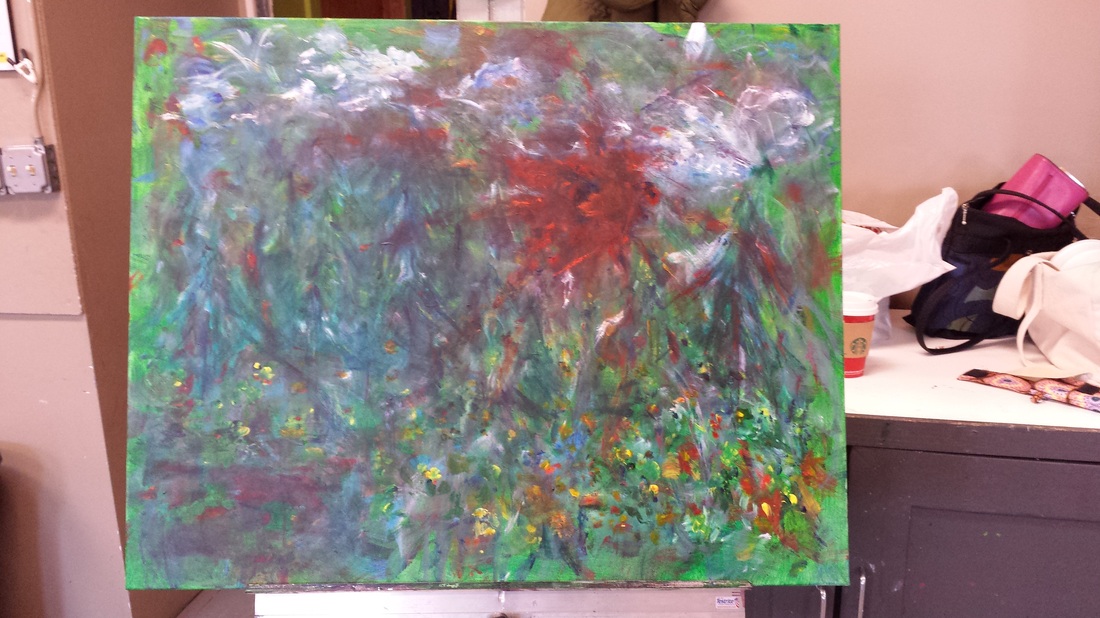
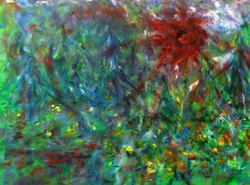
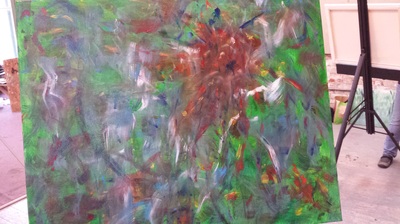
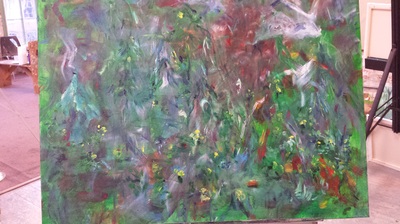
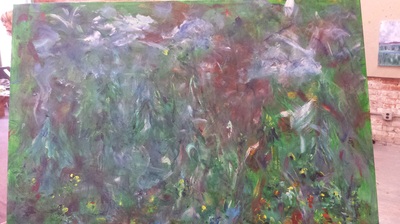
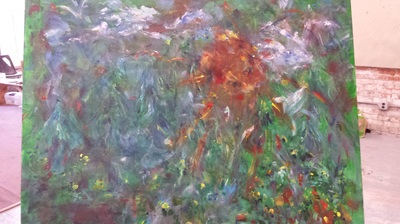
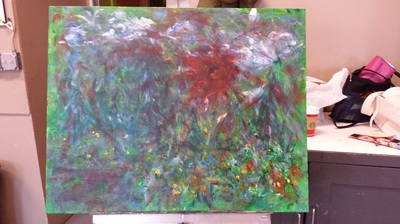
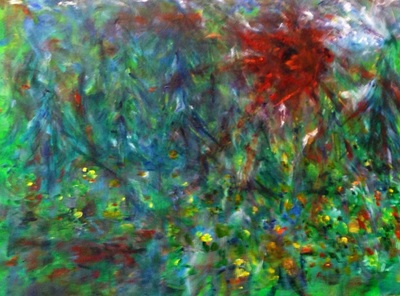
 RSS Feed
RSS Feed